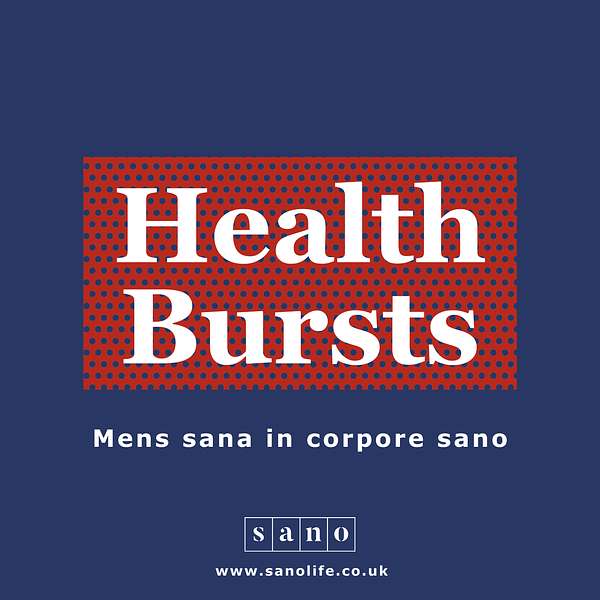
Sano Health Bursts
Sano Health Bursts
Protect your skin from the inside out
In this episode we explore how you can protect your skin from sun damage from the inside out with food. Safe sun exposure and protection is important but don't forget the important role of nutrients in protecting from skin damage, ageing and reducing the risk of skin cancer. Find out what foods you should focus on for healthy skin.
Welcome to Sano Health Bursts. I’m Heather Richards Nutritional Therapist, Director of Nutrition at Sano and nutrition lead for the College of Medicine. Sano Health Bursts are short, informative, practical sessions discussing food, nutrition and lifestyle, helping you live a healthier life.
Today we’re going to look at protecting our skin with food. Safe sun exposure is important but have you thought about also protecting your skin from the inside? Sun damage, known as photodamage, creates free radicals that cause cell damage and inflammation leading to ageing and in some cases skin cancer. When the body has a supply of antioxidants it is able to counteract the potential free radical oxidative damage reducing the risk and extent of photodamage.
Antioxidants include a group of phytochemicals, compounds in plants, called flavonoids that provide plants with their diversity of colour. Eating a diet with plenty of plants giving a wide array of colour will provide antioxidants from flavonoids and vitamin C that is abundant in peppers, berries, green and orange vegetables and citrus fruits.
In addition to flavonoids and vitamin C that are water soluble, what is really important in skin protection is compounds that act as fat-soluble antioxidants because they are able to accumulate in the fatty layers of skin.
The skin comprises 3 main layers; the epidermis is the outermost layer providing protection from the external environment and containing specialised cells such as melanocytes that produce melanin responsible for skin pigmentation.
Beneath the epidermis is the dermis that contains the structural and functional components of the skin like collagen, elastin and connective tissue, as well as the hair follicles and sweat glands.
The innermost layer, the subcutis contains fat cells and a supply of blood and lymph vessels. It is here that fat soluble antioxidants can be stored and moved into circulation when required providing protection against oxidative damage.
Carotenoids are fat-soluble phytochemicals and include beta-carotene, lutein, lycopene and zeaxanthin. Beta-carotene is an antioxidant that gives plants their orange colour. It is found in orange, red and yellow fruits and vegetables like carrots, sweet potatoes, squash, peppers, tomatoes and apricots.
It is also found in some green leafy vegetables like kale, spinach and watercress. If you ever keep these vegetables a while before using them you will notice they start to turn yellow. That is the beta-carotene that you can see as the chlorophyll that provides the green colour breaks down revealing the beta-carotene underneath.
Lycopene has been shown to absorb UVB radiation and is found in tomatoes and watermelon. Watermelon contains more lycopene than tomatoes and is thirst quenching on a hot summer's day due to its high water content. Hydration is important to avoid dry skin leaving it looking dull and developing wrinkles. Leafy green vegetables as well as containing good levels of beta-carotene contain lutein and zeaxanthin provide further protection.
Vitamin E is another fat soluble antioxidant and as well as containing carotenoids, some of the foods we have just mentioned also contain good amounts of vitamin E. Sweet potato, squash and swiss chard are all good sources. Additionally nuts and seeds, avocado, herring and sardines all have good levels of vitamin E.
Vitamin D is produced by the body in response to exposure of the skin to UVB light. It is a fat soluble vitamin and what is not often discussed is its ability to potentially offer protection against UVB damage. Several studies have demonstrated the photoprotective effects of vitamin D. Food sources of vitamin D are limited but are found in oily fish like salmon, mackerel and sardines as well as eggs and full fat dairy. There is also a small amount within mushrooms.
What should never be forgotten is the role of omega 3 fatty acids EPA and DHA that provide skin integrity as well as anti-inflammatory benefits. The best sources are oily fish such as salmon, mackerel, anchovies, sardines and herring.
So in conclusion, protect your skin from the inside to reduce oxidative damage by eating a diet full of colourful plants particularly orange, yellow, red and green leafy vegetables as well as nuts seeds and oily fish. This actually sounds very much like the mediterranean diet which isn’t surprising given their climate and the numerous health benefits associated with it.
Enjoy the sun with safe sun exposure and protection but also work from the inside out with food - and don’t forget the watermelon!
I hope you enjoyed this episode of Sano Health Bursts. If you want to learn more then subscribe to this podcast, to our newsletter, read our blogs, join our webinars or study with us. Visit our website www.sanolife.co.uk or email us at learn@sanolife.co.uk to find out more and enrol on our courses. Start improving your health today and put the tips I have given you into practice. Mens sana in corpore sano. A healthy mind in a healthy body.
Copyright Sano 2021